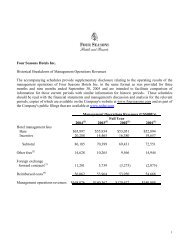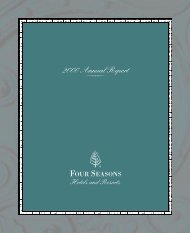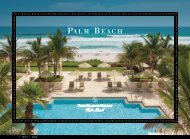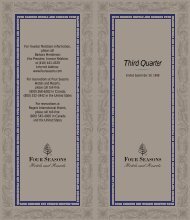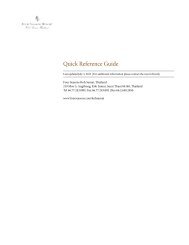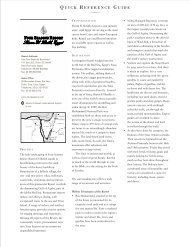1998 Annual Report - Four Seasons Hotels and Resorts
1998 Annual Report - Four Seasons Hotels and Resorts
1998 Annual Report - Four Seasons Hotels and Resorts
You also want an ePaper? Increase the reach of your titles
YUMPU automatically turns print PDFs into web optimized ePapers that Google loves.
Income Tax ExpenseThe Corporation’s effective tax rate in 1997 was 3.8%, as compared with a 6.2% effective tax rate in 1996. The low effectivetax rate is due primarily to the utilization of the benefits of the unrecorded tax losses created by the write-down in hotelinvestment values in 1993 <strong>and</strong> 1995.Net Earnings <strong>and</strong> Earnings per ShareNet earnings <strong>and</strong> earnings per share in 1997 were $40.8 million <strong>and</strong> $1.24 per share, respectively. Excluding the$12.0 million loss on repurchase of debt, normalized net earnings were $52.8 million <strong>and</strong> normalized earnings pershare were $1.61 in 1997. Net earnings in 1996 were $29.9 million <strong>and</strong> net earnings per share were $1.04. The 76.8%increase in normalized net earnings <strong>and</strong> 54.8% increase in normalized earnings per share resulted from strong growthin hotel management operations, <strong>and</strong> an increase in hotel ownership earnings primarily due to the consolidation ofThe Pierre in New York <strong>and</strong> the <strong>Four</strong> <strong>Seasons</strong> Hotel Vancouver in 1997, offsetting lower management <strong>and</strong> ownershipearnings from the Corporation’s Asian hotels, <strong>and</strong> lower net interest costs resulting from declining debt levels, lowerinterest rates <strong>and</strong> increased interest income in 1997.L I Q U I D I T Y<strong>Four</strong> <strong>Seasons</strong> generally funds its capital <strong>and</strong> operating requirements with cash flow from operations <strong>and</strong> its available banklines. The Corporation utilizes cash from operations, debt <strong>and</strong> equity financing to (i) make capital investments to obtainlong-term management agreements <strong>and</strong> to enhance existing management agreements, (ii) fund its share of hotel capitalimprovements <strong>and</strong> operating requirements where it holds an equity interest <strong>and</strong> where the operating cash flow from thesehotels is insufficient to fund these requirements, <strong>and</strong> (iii) make principal <strong>and</strong> interest payments on corporate debt.In 1999, based upon the current business plan, the Corporation expects total capital spending of approximately$75 million, including dividends <strong>and</strong> those items noted on pages 45 <strong>and</strong> 46, which will be funded from cash on h<strong>and</strong> <strong>and</strong>cash generated by operations. In addition to this expected capital spending, the Corporation is also expecting to fundapproximately US$11 million (approximately $17 million) in a resort <strong>and</strong> vacation ownership project under construction inScottsdale, Arizona <strong>and</strong> approximately US$12 million (approximately $18 million) relating to the construction of the <strong>Four</strong> <strong>Seasons</strong> HotelCapital Spread Analysis (percent)Prague. These two investments would be funded from cash generated25from operations, as well as from the Corporation’s bank credit facilities.20It is the Corporation’s strategic objective to reduce its equity15commitment to the Prague <strong>and</strong> Scottsdale projects to be consistent10with its more typical minority ownership interest5or loan structures.0-5-10-15-2094 95 96 97Return on Capital Cost of Capital Spread98<strong>Annual</strong> Data from 1994 through <strong>1998</strong>Source: Goldman, Sachs & Co.43<strong>Four</strong> <strong>Seasons</strong> <strong>Hotels</strong> Inc.



